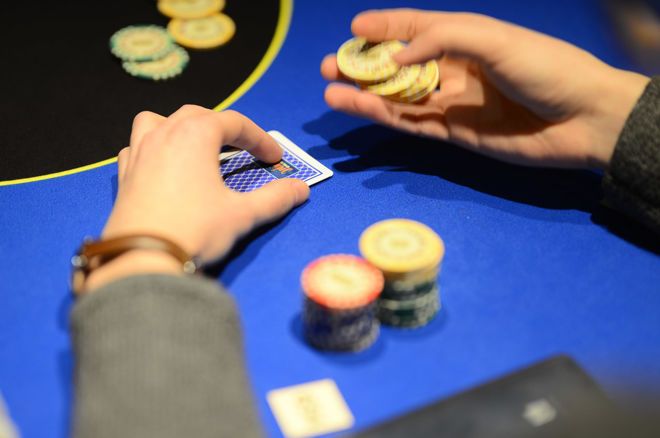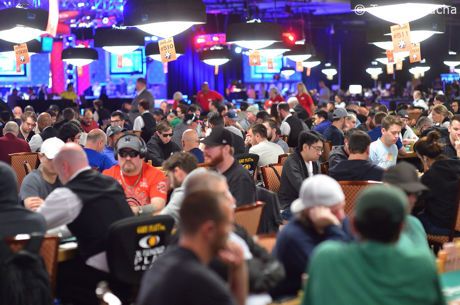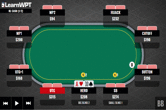To Wait or Decloak? A Discussion About Slow Playing

I spend a fair amount of time reading a private hand discussion group on Facebook. It's an ongoing series of real-world poker problems that force me to evaluate, learn, and grow as a poker player. This one caught my eye because I initially felt the writer had made a moderately serious mistake at a key point in the hand.
Our hero was playing in $2/$5 no-limit hold'em cash game. A loose player opened in early position to $20, got one caller, and the hero called in the hijack seat with pocket sevens. The effective stacks were $1,200, which gave him plenty of room to set mine.
With $65 in the pot, the flop was T-7-3 rainbow. The opener bet $30, the player in the middle folded, and our hero chose to call with middle set.
While I'm usually a fan of playing big hands fast, just calling here seems fine. It's a dry board and unless the villain has an overpair or a ten, he probably wouldn't be able to call a raise. With $125 in the pot, the turn was a king, completing the rainbow. The board was now T-7-3-K.
The villain bet $60 and our hero chose to call again. We'll get to the rest of the action in a minute. The crux of the poker problem is here. Two of the pro players in our group liked the hero's line. They said it was fine to call the turn, with the intention of raising (or betting big) on the river. I posted to disagree. I felt the hero should have raised right there on the turn with the intention of putting in a big bet on the river.
Before we investigate that disagreement, let's discuss the area of agreement: this turn card should be good for the hero. It's quite possible the villain opened with a hand such as A-K or K-Q and then continuation bet the flop. Now the villain has hit top pair (presumably with a good kicker) but is drawing dead.
But then, as the thread unraveled, the thinking boiled down to two schools of thought.
Those in the "Call the Turn" school felt that, from the villain's perspective, a raise by the hero looked incredibly strong and was unlikely to be a bluff. An aware villain would realize that he is in deep (perhaps inescapable) trouble and folds his top pair without further pain. By calling, the hero can represent a weaker hand that is calling along, and then spring the trap on the river. If the villain checks the river, that's unfortunate, but at least the hero now gets to pick his price. Perhaps $100 into the $245 pot, targeting a hand such as A-K or K-Q.
Members of the "Raise the Turn" school said that since the villain is strong, but we're stronger, let's build a pot. Raise to $150, and when he calls, plan a bet on the river that targets that same strong king. Maybe $150 or $200 into the $425 pot.
There are also secondary reasons for raising. First, suppose the villain has a very strong hand such as K-T or 3-3. If so, it would be malpractice to slow play the turn. It's a mathematical catastrophe to give a cheap card (by not raising) to a hand that sucks out on us and gets our stack, particularly when the draw would call a big turn raise.
But more likely, and more importantly, the river can bring a card that freezes the action and causes the villain to slow down. Get the money in when he thinks that top-pair-top-kicker or top-two-pair is the nuts, and let scary river cards be less material.
Ultimately, the decision point came to this: Would the villain be able to fold a hand as strong as A-K, K-Q, or even A-A to a raise on the turn?
The lead pro in the group (who plays $5/$10 and up) said that this skill has become ingrained in most players �� that it's part of the evolution of the herd. I countered that some of my best profits in low stakes games ($1/$2, $1/$3, and some $2/$5) come from very good one-pair hands paying off big late street bets and raises. I agree they "shouldn't" pay off those bets (they are simply far too value-heavy). But many players do, and our hero should punish the villain for that failing.
Poker can be hard and confusing, and there is no "one size fits all" solution for our hero in this hand. But at least we've distilled the core question: "If I raise on the turn, will the villain be able to fold top pair, an overpair, or two pair?" If so, call. Otherwise, raise.
Because everybody always wants to know... the river was an ace. The villain checked, our hero bet $150, and the villain merely called with A-K, which was top two pair! That was certainly not the hand any of us expected, as the villain had taken a strangely passive (though fortunate for him) line.
I loved how the discussion illuminated the crucial question that our hero had to answer: To wait or decloak. It's always a fun question to face, because it means we have a monster hand!
Lee Jones can help you distill poker's complex situations into simple questions, and then answer those questions. go to leejones.com/coaching and schedule a free coaching consultation. Lee specializes in coaching low-stakes cash game players.









